Here is an introduction to the LiFePO₄ battery - powered motion - sensor - equipped DC 80W output system:
The battery-powered motion sensor system, with a DC output capacity of 80W, is an intelligent device that combines environmental perception with electrical energy output. This system takes high-performance batteries (such as lithium iron phosphate batteries) as the power source. With their high energy density, long cycle life and excellent safety performance, it provides reliable power guarantee for the stable operation of the system.
The motion sensor, as the core component, adopts passive infrared (PIR), microwave sensing or dual-mode fusion technology, which can keenly capture the movement of the human body or objects. When the sensor detects an effective motion signal, it will quickly trigger the built-in control circuit, activate the power output module, and stably output 80W DC electrical energy, which can drive various compatible devices, such as lighting fixtures, small fans, portable display screens, etc.
In practical applications, this system demonstrates strong flexibility and energy-saving advantages. For example, in the intelligent lighting scenario, when personnel enter the sensing area, the sensor immediately activates 80W DC power supply and lights up the high-brightness LED lamps to provide sufficient lighting. After the personnel leave, the system automatically cuts off the power, effectively avoiding energy waste. Its control circuit integrates intelligent power regulation and overcurrent, overvoltage and short-circuit protection functions to ensure stable operation in complex environments. In addition, the modular design facilitates integration with battery packs, sensors and load devices of different specifications, and is widely applicable in smart home, industrial monitoring, outdoor emergency response and other fields, achieving on-demand energy supply and improving energy utilization efficiency.

-
LiFePO₄ Battery: It is the power source of the system. LiFePO₄ batteries have advantages such as high energy density, long cycle life, good safety performance, and low self - discharge rate. For an 80W output system, a battery pack with appropriate capacity and voltage needs to be selected according to the specific working time and load requirements. Usually, a battery pack with a voltage of 24V or 48V and a capacity of several Ah to tens of Ah may be required.
-
Motion Sensor: The motion sensor is used to detect the movement of objects in the surrounding environment. It can be a passive infrared sensor (PIR), a microwave sensor, or a combination of both. When the sensor detects motion, it sends a signal to the control circuit to trigger the output of the 80W DC power.
-
Control Circuit: The control circuit is responsible for regulating and controlling the entire system. It includes functions such as battery charging and discharging management, motion sensor signal processing, and output power regulation. The control circuit ensures the stable operation of the system and the efficient use of battery power.
-
DC - DC Converter: If the output voltage of the LiFePO₄ battery is not the same as the required input voltage of the 80W load, a DC - DC converter is needed to convert the battery voltage to the appropriate voltage for the load. The DC - DC converter has high conversion efficiency to minimize energy loss.

-
Standby Mode: When there is no motion detected by the motion sensor, the system is in standby mode. In this mode, the control circuit monitors the battery voltage and the status of the motion sensor. The power consumption of the system is very low to save battery power.
-
Trigger Mode: When the motion sensor detects motion, it sends a signal to the control circuit. The control circuit then activates the DC - DC converter to output 80W of DC power to drive the load, such as a light or a fan. The system remains in the triggered state for a certain period of time, which can be set according to specific needs, usually ranging from several seconds to several minutes. After this period, if no further motion is detected, the system returns to standby mode.
-
Energy - saving: The system only consumes power when motion is detected, which can effectively save energy compared to continuous - operation systems. This is especially suitable for applications where the load does not need to be constantly powered, such as some public - area lighting or ventilation systems.
-
High Reliability: LiFePO₄ batteries have good safety and stability, and the motion sensor and control circuit are also designed to be reliable. The entire system has a low failure rate and can work stably for a long time.
-
Flexible Application: The system can be easily installed and configured in different environments. It can be used for lighting control in corridors, stairwells, parking lots, and other places, as well as for powering some small - power equipment that needs to be triggered by motion.
-
Battery Capacity and Charging: The capacity of the LiFePO₄ battery should be selected according to the expected working time and the frequency of motion detection. It is necessary to ensure that the battery can provide sufficient power to meet the needs of the system. At the same time, a reasonable charging method should be adopted to ensure the normal use and service life of the battery.
-
Sensor Sensitivity and Range: The sensitivity and detection range of the motion sensor need to be adjusted according to the specific application environment. If the sensor is too sensitive, it may cause false triggering; if it is not sensitive enough, it may fail to detect motion. Therefore, it is necessary to conduct field tests and adjustments to ensure the proper operation of the sensor.
-
Load Compatibility: When selecting a load, it is necessary to ensure that the load is compatible with the 80W DC output of the system. The rated voltage, current, and power of the load should match the output characteristics of the system to avoid damage to the load or the system.



 Language
Language English
English français
français العربية
العربية 中文
中文 sales@szleadray.com
sales@szleadray.com +86-13424390319
+86-13424390319







